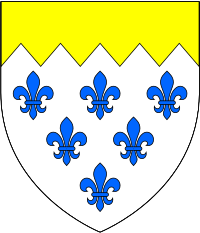| The Right HonourableThe Earl of YarmouthFRS | |
|---|---|
 The Earl of Yarmouth, by Burnet Reading The Earl of Yarmouth, by Burnet Reading | |
| Member of the England Parliament for Castle Rising | |
| In office 1661–1673Serving with
| |
| Preceded by | |
| Succeeded by | |
| Member of the England Parliament for Thetford | |
| In office 1660–1661Serving with Sir Philip Wodehouse | |
| Preceded by | |
| Succeeded by | |
| Personal details | |
| Born | Robert Paston (1631-05-03)3 May 1631 |
| Died | 8 March 1683(1683-03-08) (aged 51) |
| Spouse |
Rebecca Clayton (m. 1650) |
| Children | 9, including William Paston, 2nd Earl of Yarmouth |
| Parents |
|
| Residence(s) | Richmond, London, England |
Robert Paston, 1st Earl of Yarmouth, FRS (29 May 1631 – 8 March 1683) was an English scientist and politician who sat in the House of Commons between 1660 and 1673 when he was created Viscount Yarmouth. He was created Earl of Yarmouth in 1679.
Life
Paston was the son of Sir William Paston, 1st Baronet of Oxnead and his first wife, Lady Katherine Bertie, daughter of Robert Bertie, 1st Earl of Lindsey. He was educated at Westminster School and was a student of Trinity College, Cambridge in 1646. He travelled abroad in France. In 1660 he was elected Member of Parliament (MP) for Thetford in the Convention Parliament. He was knighted on 27 May 1660.
In 1661, Paston was elected MP for Castle Rising and sat until 1673, when he had to relinquish his seat on being raised to the peerage as Viscount Yarmouth. He had inherited the baronetcy on the death of his father in 1663. He was appointed Lord Lieutenant of Norfolk on 6 March 1676, retaining the office until his death. He was created the 1st Earl of Yarmouth in 1679.
Following the creation of the Royal Society in 1660, he was accepted as an Original Fellow on 20 May 1663. With another Fellow, Thomas Henshaw, he attempted to discover a formula for the fabled "red elixir", another name for the philosopher's stone which alchemists believed could transmute base metals into gold. In a letter to Sir Thomas Browne he informed the Norwich physician-philosopher of his alchemical experiments -
- I have at Oxnead seen this salt change black as ink, I must, at the lowest, have an excellent aurum potable, and if the signs we are to judge in Sendivogius’ description be true, I have the key which answers to what he says, that if a man has that which will disolve [sic?] gold as warm water doth ice, you have that which gold was first made in the earth.
Paston lived at Richmond. In May 1666, he wrote a letter to his wife mentioning "a game of criquett on Richmond Green", the first known reference to cricket at Richmond Green.
There is a painting in the Norwich Castle Museum, of Robert Paston and his father William's artefact collection known as The Paston Treasure.
Family
Paston married Rebecca Clayton, daughter of Sir Jasper Clayton, Haberdasher, of London on 15 June 1650. They had six sons and three daughters. Rebecca died on 16 February 1694.
Their son, William, married Lady Charlotte Fitzroy, an illegitimate daughter of Charles II. Both Robert and his son were in high favour with the Stuarts.
Arms
  |
|
See also
References
- ^ Paston, Robert, HistoryofParliamentOnline.org. Accessed 12 January 2023.
- Notes and Records of the Royal Society,Volume 51, Number 1, pp57-76
- Correspondence dated September 10th 1674 in Vol. 3 Collected works of Sir Thomas Browne ed. Simon Wilkins Pickering and Co. 1834
- "Cricket in 19th century Norfolk: the legend of Fuller Pilch". Norfolk Record Office. 30 June 2016. Retrieved 30 March 2022.
- The Paston Treasure Retrieved 30 March 2011
- "Yarmouth, Earl of (E, 1679 - 1732)".
| Parliament of England | ||
|---|---|---|
| Preceded byRobert Steward William Stene |
Member of Parliament for Thetford 1660 (April) With: Sir Philip Wodehouse, Bt |
Succeeded bySir Allen Apsley William Gawdy |
| Preceded bySir John Holland, Bt John Spelman |
Member of Parliament for Castle Rising 1661–1673 With: Robert Steward 1661–1673 Sir John Trevor 1673 |
Succeeded bySir John Trevor Samuel Pepys |
| Honorary titles | ||
| Preceded byThe Viscount Townshend | Lord Lieutenant of Norfolk 1676–1683 |
Succeeded byEarl of Arundel and Surrey |
| Vice-Admiral of Norfolk 1676–1683 |
VacantTitle next held bySir Henry Hobart | |
| Peerage of England | ||
| New creation | Earl of Yarmouth 1679–1683 |
Succeeded byWilliam Paston |
| Viscount Yarmouth 1673–1683 | ||
| Baronetage of England | ||
| Preceded byWilliam Paston | Baronet (of Paston and Oxnead, Norfolk) 1663–1683 |
Succeeded byWilliam Paston |